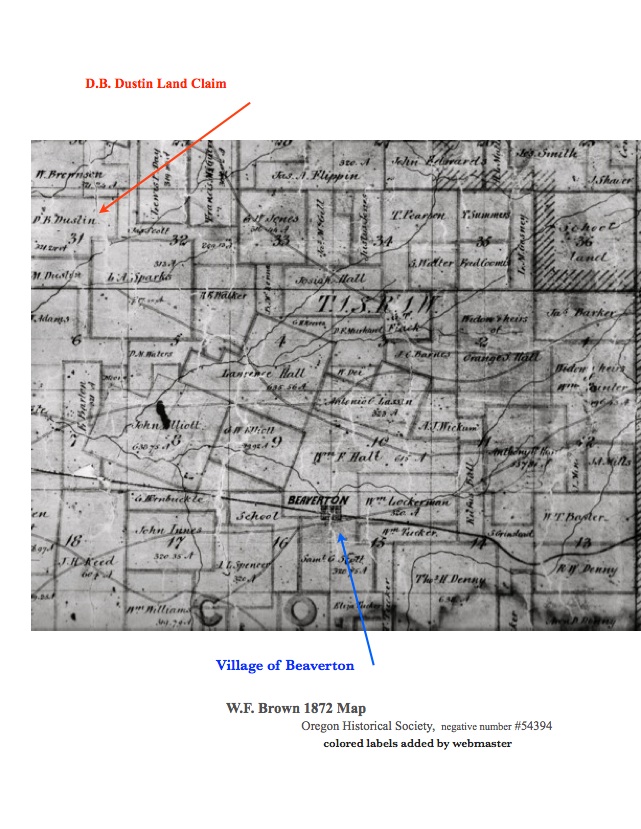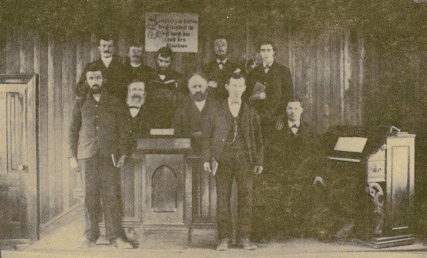1872—1880s in *Beaverdam, Washington County, Oregon


A second wave of settlers claimed or bought land during the 1870s after some of the original donation land claims were divided into smaller parcels. The countryside was heavily forested and the work of the beaver was evident in the streams. Many people in Europe faced famine, overpopulation, and religious persecution. Most migrated seeking a better economic future and religious freedom. They found it in the Northwest and the word spread.
Berger Brothers
In 1872, the Berger brothers, Jakob, Peter and Johann persuaded their parents, brothers and sisters to migrate here from Switzerland. With them came other Swiss people and families: Christian Linder; Daniel Stoller; John Ritter; and Christian Zuercher.
June 15, 1873 Linder, at home in a new land, met with others to organize a new church— “Erste Deutsche Presbyterianische Kirche zu Bethany” —the first German Presbyterian Church of Bethany.
The Presbyterians started other churches in Centerville in 1878 and Buxton. The Methodists built a church in Hillsboro. These religious organizations played an important part in the early life on the Tualatin Plains. Their meetinghouses sometimes served as the first seats of county government, their earliest leaders were among the first tillers of the soil in the valley.

Samuel Siegenthaler
Samuel Siegenthaler, a prosperous Swiss farmer, planned to bring his family to the Pacific Northwest in 1876. His family included his wife Elizabeth, (39) children Anna, (14) Rosette, (12) Mary, (10) Lydia, (2) baby Gotfred and his nephew Christian Schindler, (14). Another family with 10 children joined him. Others who were in search of religious freedom and a better economic future wanted to join the migration. Ten families plus a few single people [72 in all] were eager to travel to the new world.
Some of the families were: Jakob Losli; Eggimann; Fred Schaer; J.Guerber; Andrews brothers and sisters; Peter and Anna Wyman; Ulrich and Barbara Guerber; Samuel Josi, and Bernhard Scheitlin.
Siegenthaler advanced passage money to those who needed it. Families sold their land holdings, pooled their money and corresponded with earlier Tualatin Valley settlers who helped make arrangements for their arrival. Siegenthaler bought all the tickets, did the conversing for the party, and paid the bills. Taking a ship from France, they traveled third class with meager meals on rough seas. Many were very seasick. Tickets and money were carried in a satchel strapped around Siegenthaler’s shoulders. At night another man always slept next to him to help protect their treasury.
From New York they took a train to Philadelphia. It was an immigrant car hooked to a freight train. The children slept on the seats and adults had to sleep on the floor with the baggage. Another train took them on to Omaha, and finally Sacramento. No meals were served on the trains, the depot restaurants too costly, so at stops they walked to stores for food. There was a little stove at the back of the car where the mothers could heat the milk for the babies.
Then they traveled to San Francisco by boat and waited several days for a steamer to complete their journey to Portland, which they reached five weeks after leaving Switzerland.
Siegenthaler bought several hundred acres of land most of it heavily timbered, and parceled it out among families. He again financially helped those who needed it. He charged no interest, and accepted payment when the family farms were established and able. They chopped through the forests to built their own homesteads. Slowly they started to clear the land and establish their farms in an area that reminded them of their homeland left behind.
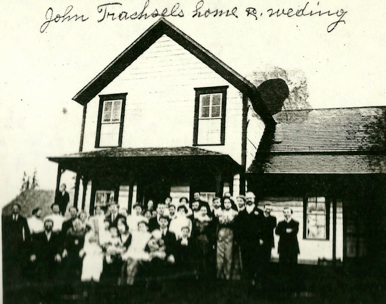
Trachsel Family photo
Trachsel
In 1883 John Trachsel had married Adelina in Switzerland, and arrived in America in 1891 with their young family. Eventually they had eight children. Photo above shows the John Trachsel home and wedding.
Jacob Trachsel, was a Swiss farmer who also arrived in 1891 with his wife Susie and family. His farmland was next to the John Trachsel family. The Trachsel children attended McKinley.
Stucki
Fred Stucki, Swiss settler, was 20 when he came to the community in 1887. He bought 120 acres of forest land. It was not really a farm because only 20 acres were clear in a stand of timber. The other 100 acres were heavily wooded. He cut the trees, used dynamite to clear the stumps, horse power and lots of hard work. Little by little, year by year, the land was cleared and plowed, just a few acres at a time. In 1893 Fred married a Swiss girl, Elisa Zimmerman. She had arrived in Washington County in 1868 at the age of two. The lumber for their new house was from a local sawmill on West Union and Rock Creek. It was Eliza’s suggestion that they collect the milk rather than selling it to the creamery and make Swiss cheese. They started making the Swiss cheese and sold it locally, delivered to Portland weekly, and shipped some to ten states. They did this almost continuously for 51 years. 12 children were born to the Stucki family. The children attended McKinley School.
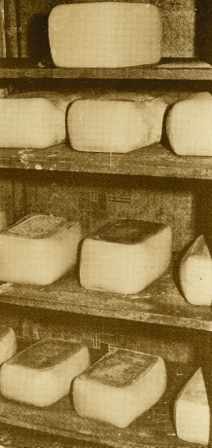
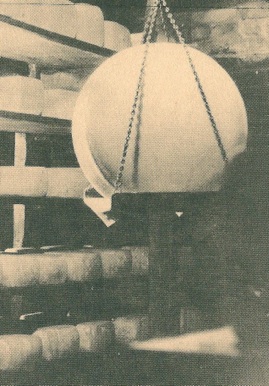
Round of Swiss Cheese 1934 (right photo)
Swiss cheese aging on the shelf (left photo) in the Stucki Cheese Kitchen. The newest cheese was on the top, the aged cheese on the bottom.
Cheese Kitchen
Cheese kitchen built on the Stucki farm in 1914 was a small simple building 14 x 20 feet. A large black cast iron cheese kettle was hung over the fire. Twelve gallons of milk would be heated, then the morning milk would be added to start the Swiss cheese recipe.
Esther Stucki, one of the youngest girls, in the Cheese kitchen with a big black cast iron cheese kettle.
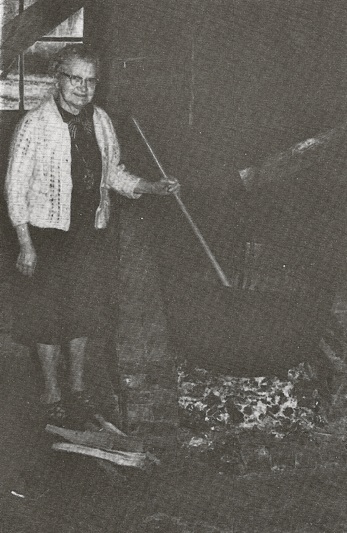
Stucki Family photos
*Beaverdam Many of the early documents and the US Federal Census during 1880—1910 refer to the area as Beaverdam. It was so heavily forested and there were many streams and creeks where the Beaver had created dams—so the name Beaverdam.
Stucki Family photo
